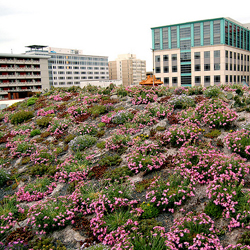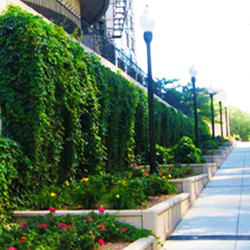Professional Practice
Green Infrastructure: Green Roofs and Walls
Green roofs can help regulate a building’s internal temperature,
reduce stormwater runoff, and mitigate the urban heat island effect.
Green roofs offer significant economic benefits, including a longer roof
life and heating and cooling energy savings. Green roofs also provide
an opportunity for urban food production, and increasing urban
biodiversity. If well-designed and cared for, green roofs can offer people the psychological benefits of nature.
For more information on residential infrastructure, please visit our Residential Design Guides: Water, Energy, Planting, and Low-Impact Materials.
Green roofs benefits include:
Economic
- Green roofs can extend a roof’s
lifespan by two or three times. According to Sustainable South Bronx, on a
90 degree day a green roof is about 80°F, while a black roof is 175°F,
causing substantial wear and tear.
- A
University of Michigan study showed that a 21,000 square feet $464,000
green roof will save $200,000 over its lifetime. “Nearly two-thirds of
these savings would come from reduced energy needs for the building with
the green roof.” (1)
Energy Use
- Energy
savings: A typical 2-3 story building could experience 15-25 percent
savings in summertime energy costs. (1)
Water Management
- Green roofs can catch 40-60 percent of stormwater, reducing flow
into a city’s sewers (1)
- Green roofs led
to approximately 65 percent reduced peak flows and 55 percent reduced runoff volumes, according to an E.P.A. overview of peer-reviewed literature. (2)
- Modelling
conducted on Manchester, England, found that adding green roofs to all
buildings in town centers, retail, and high-density residential could
reduce run off by 17 - 20 percent. (3)
- The green roof on FedEx’s Main Sorting Facility at O’Hare covers
nearly 175,000 square feet, captures close to two million gallons of stormwater
annually, and will save the company an estimated $35,000 in energy costs per
year. (4)
Reducing Air Pollution, Urban Heat, &
Atmospheric Carbon Levels
- A study quantifying ecosystem services
resulting from Portland, Oregon’s green infrastructure practices in 2009 found that green roofs reduced particulate matter less than 10 micrometers in diameter (PM-10) by 7.7 lbs, created 8,270 + kWh/Acre
energy savings, and sequestered 7.1 metric tonnes of carbon emissions per acre per year. (5)
Urban Heat
- A modeling study found that adding green
roofs to 50 percent of the available surfaces in downtown Toronto would
cool the entire city by 0.2 to 1.4°F (0.1 to 0.8°C). (1)
- A Toronto study found two green roofs with minimal vegetation reduced peak summertime roof membrane temperatures by 35°F and summertime heat
flow through roofs by 70-90 percent compared with a conventional roof,
substantially reducing energy needs for cooling. (1)
- A study conducted at the University of Central Florida found the maximum average day temperatures for conventional roof surface was 130°F,
while the maximum average for green roof was 91°F, which is 39°F lower than the
conventional roof. (1)
Green walls include most of the benefits of green roofs, but also:
- Temperatures behind green walls can be reduced by as much as 10 degree celsius.
- Green walls can help reduce sound reflection
- Through shading, green walls can lower temperatures in summer and reduce energy costs by 23 percent. (6)
Sources:
1. "Reducing Urban Heat Islands: Compendium of Strategies, Green Roofs,” U.S. Environmental Protection Agency and Sustainable South Bronx
2. “The Illinois Green Infrastructure Study,” Illinois Environmental Protection Agency
3. “Microeconomic Evidence for the Benefits of Investment in the Environment – review.” Natural England
4. “Banking on Green: A Look at How Green Infrastructure Can Save Municipalities Money and Provide Economic Benefits Community-wide.” ASLA
5. “Portland’s Green Infrastructure: Quantifying the Health, Energy, and Community Livability Benefits,” Environmental Services, City of Portland
6. “Living Walls: A Way to Green the Environment” Susan Loh, Australian Council of Built Environment Design Professionals, August 2008
Organizations
Green Roofs for Healthy Cities
Center for Green Roof Research, Pennsylvania State University
International Green Roof Association
Resources
"Despite Economy, Green Roofs Bloom," The Dirt
"Green Roofs Reduce the Urban Heat Island Effect," The Dirt
"Majora Carter on Green Community Infrastructure," The Dirt
"Philadelphia's Cutting-edge Green Infrastructure Plan," The Dirt
"Scaling up Green Infrastructure," The Dirt
"Taking Nature to the City," The Dirt
Government Resources
“By-Law to Require and Govern the Construction of Green Roofs in Toronto,”
Chief Building Official and Executive Director, Toronto Building and
Chief Planner and Executive Director, City Planning, March 2009
Reducing Environmental Heat Islands: Green Roofs (U.S. Environmental Protection Agency)
Report on the Environmental Benefits and Costs of Green Roof Technology (City of Toronto Government, Canada)
Research
 American Society of Landscape Architects (ASLA) Headquarters Green Roof, Washington, D.C. / Image credit: ASLA
American Society of Landscape Architects (ASLA) Headquarters Green Roof, Washington, D.C. / Image credit: ASLA
"Planning for a Cooler Future: Green Infrastructure to Reduce Urban Heat," Urban Affairs, 2013
"Evaluation of Green Roof Plants and Materials for Semi-Arid Climates," Environmental Protection Agency, 2012
“Capturing Rainwater from Rooftops: An Efficient Water Resource Management Strategy that Increases Supply and Reduces Pollution,” Natural Resource Defense Council (NRDC), 2011
"Green Roofs for Stormwater Runoff Control," Environmental Protection Agency, 2009
"Gray to Green: Jumpstarting Private Sector Investment in Green Stormwater Infrastructure," Green Economy Taskforce, Sustainable Business Network of Greater Philadelphia, 2009
“What is a Green Roof?” How Stuff Works
“Urban Heat Island Mitigation Can Improve NYC’s Environment: Research on the Impacts of Mitigation Strategies,” Sustainable South Bronx, October 2008
“Reforesting the Built Environment: A Practical Feasibility Case Study in Christchurch,” K.J. Mulligan and S.C. Page, 2008
“Sound Transmission Loss of Green Roofs,” Maureen Connelly and Murray Hodgson, 2008
“Reducing Urban Heat Islands: Compendium of Strategies, Green Roofs,” U.S. Environmental Protection Agency
"Introduction to Green Walls Technology, Benefits and Design," Green Roofs for Healthy Cities, September 2008
“Living Walls: A Way to Green the Built Environment,” Susan Loh, Australian Council of Built Environment Design Professionals, August 2008
“Quantifying
Evaporation and Transpirational Water Losses from Green Roofs and Green
Roof Media Capacity for Neutralizing Acid Rain,” Robert Berghage,
Al Jarrett, David Beattie, Kathleen Kelley, Shazia Husain, Farzaneh
Rezai, Bret Long, Ayako Negassi, Robert Cameron, and William Hunt, 2007
"When Does Green Infrastructure Make Sense? Comparing Conventional Systems with Green Infrastructure," Water Environment Research Foundation, June 2007
“Green Roofs in the New York Metropolitan Region: Research Report,”
Cynthia Rosenzweig, Stuart Gaffin, and Lily Parshall (editors),
Columbia University Center for Climate Change Research and NASA Goddard
Institute for Space Studies, 2006
“Mitigating New York City’s Heat Island with Urban Forestry, Living Roofs, and Light Surfaces,” New York State Energy Research and Development Authority, October 2006
“Living Architecture Monitor, Fall 2008,” Green Roofs for Healthy Cities
“Green Roof Systems: A Guide to the Planning, Design and Construction of Building Over Structure,” Susan Weiler and Katrin Scholz-Barth, Wiley, 2005
Role of the Landscape Architect
 American Society of Landscape Architects (ASLA) Headquarters Green Roof, Washington, D.C. / Image credit: ASLA
American Society of Landscape Architects (ASLA) Headquarters Green Roof, Washington, D.C. / Image credit: ASLA
At the larger scale, landscape architects analyze the context and connectivity of green roofs within the urban
landscape, seeing them as opportunities to create networks for wildlife habitat and stormwater management. Landscape architects also play a primary role in the details of green roof design, from selecting the plants to specifying the growth media and structural elements. Landscape architects also take advantage of the psychological benefits of providing more access to green vegetation and outdoor social spaces. From small urban rowhomes to apartment and office buildings and large institutions such as schools and government buildings, landscape architects meld the many social, educational, economic, and ecological benefits of green roofs.
Projects
ASLA Headquarters Green Roof, Washington, D.C. (Michael Van Valkenburgh & Associates, Inc.)
Brooklyn Botanic Garden Visitors Center, Brooklyn (HMWhite)
California Academy of Sciences, San Francisco, CA (SWA Group)
Changi Airport Terminal 3 Interior Landscape, Singapore (Tierra Design (S) Pte Ltd.)
Chicago City Hall Green Roof, Chicago, Illinois (Conservation Design Forum)
 ASLA 2011 Professional Analysis and Planning Honor Award, Adding Green to Urban Design Chicago, City of Chicago / Image credit: City of Chicago and Hitchcock Design Group
ASLA 2011 Professional Analysis and Planning Honor Award, Adding Green to Urban Design Chicago, City of Chicago / Image credit: City of Chicago and Hitchcock Design Group
Corporate Headquarters, San Francisco, CA (OLIN)
Gannett/USA Today Headquarters, McLean, Virginia (Michael Vergason Landscape Architects, Ltd.)
Green Roof Innovation Testing (GRIT) Laboratory, Toronto (University of Toronto, John H. Daniels
Faculty of Architecture, Landscape, and Design)
Lafayette Greens: Urban Agriculture, Urban Fabric, Urban Sustainability, Detroit (Kenneth
Weikal Landscape Architecture)
Manassas Park Elementary School Landscape, Manassas Park, VA (Siteworks)
Macallen Building, South Boston, MA (Landworks Studio, Inc.)
Museo del Acero Horno3, Monterrey, Mexico (Surfacedesign Inc.+ Harari arquitectos)
NYC Parks Green Roof: A Living Laboratory for Innovative Green Roof Design, New York, NY (NYC Parks)
Nueva School, Hillsborough, California (Andrea Cochran Landscape Architects)
Rooftop Haven for Urban Agriculture, Chicago, Illinois (Hoerr Schaudt Landscape Architects)
Washington Mutual Center Roof Garden, Seattle, Washington (Phillips Farevaag Smallenberg)
Animations
Leveraging the Landscape to Manage Water, ASLA
<< Constructed Wetlands